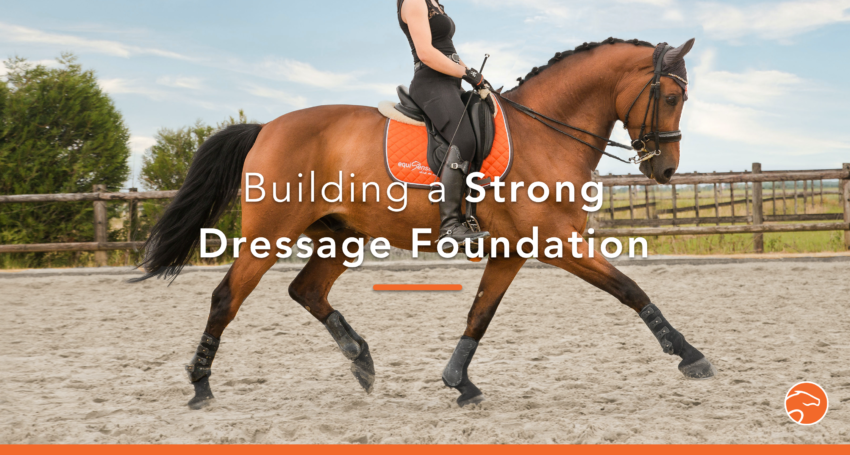
3 Exercises to Improve Your Dressage in Line with the Training Pyramid
Dressage is often referred to as the “Ballet for Horses” or “Gymnastics for Horses” and when you watch the amazing riders at the Olympics you can understand why, but nowadays when we hear the word Dressage it either inspires excitement or sends us running ( mostly by the eventers) …
The actual word Dressage derives from the french word dresseur, meaning to train. In order to be able to create the effortless look we admire upon from the top level rides, complete trust and confidence are required from both the horse and rider, however, this only comes after years of practice and dedication.
Dressage training is imperative to build strong and consistent muscles in your horse, no matter what discipline you do. Therefore, in this article we will go through some basic exercises you can do with your horse to improve your dressage.
First things first…let’s talk about the:
Table des matières
The Dressage Pyramid
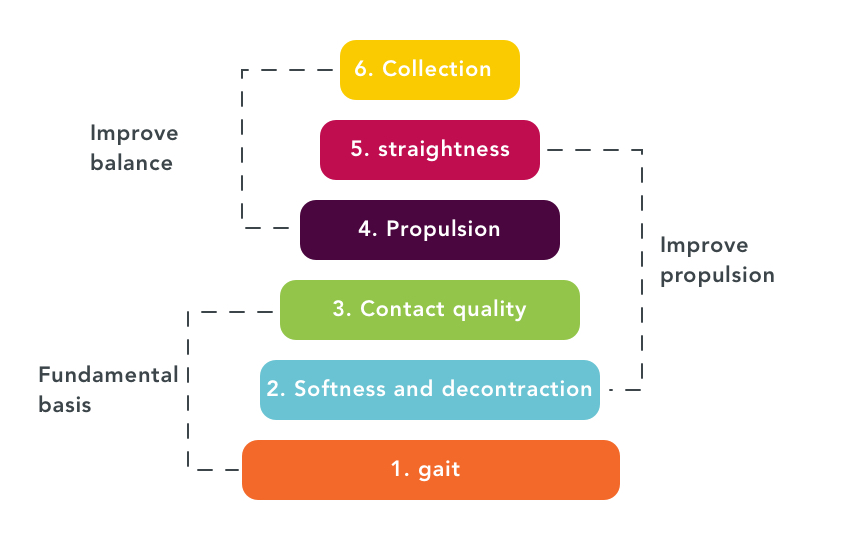
The dressage pyramid depicts the fundamental training of dressage: Judges use it to evaluate dressage tests, riders use it to make their sessions productive and trainers use it to develop their young horses in a logical and harmonious way.
As we can see, no matter who you are, if you work with horses in some sort of way, you will use the dressage pyramid.
In simple terms, the basis of the dressage pyramid is so you can train your horse effectively and properly.
For example, you cannot ask your horse for collection if you do not have rhythm and relaxation first.
💡 Riding Tip: Take the Pyramid of Training on board as part of your thinking when you train because it will save you a lot of time and frustration.
No matter what discipline you ride, these exercises are still important to note as they can be very helpful for your overall riding
Rhythm & Relaxation
What exactly does it mean?
The definition of rhythm is “a strong, regular repeated pattern of movement or sound”. This refers to the regularity of your horse’s gait, how they move and how their hooves fall in a specific pattern. Just to be clear, rhythm is not about how fast your horse’s hooves touch the ground, that is tempo. Rhythm is the beat pattern of movement in which your horse’s hooves fall one after the other.
According to the USDF Directory in the Glossary of Judging Terms, rhythm is defined as “the characteristic sequence of footfalls and phases of a given gait. For purposes of dressage, the only correct rhythms are those of the pure walk, pure trot and pure canter (not those of amble, pace, rack, etc.) Not to be confused with “tempo,” “cadence” or miles per hour.”
Using the Equisense app, we have some great groundwork exercises also to help your horse stretch! Click here
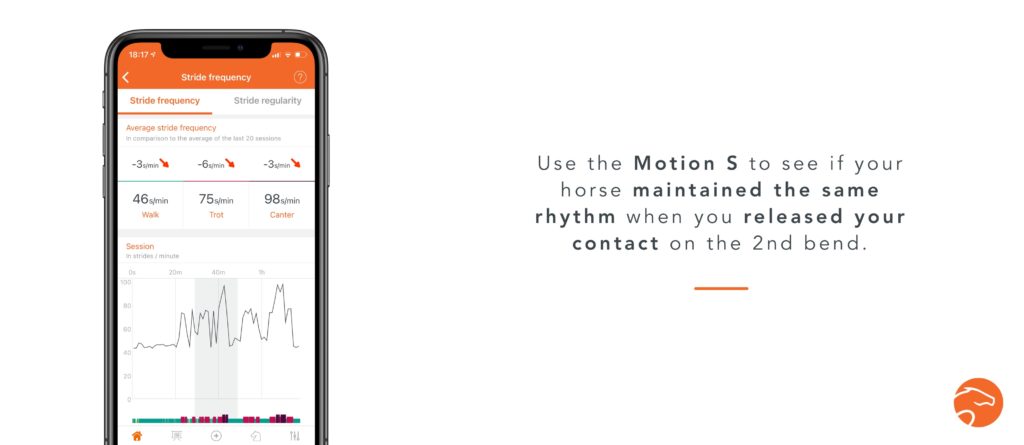
Exercise #1
When we talk about rhythm & relaxation, we must bring it right back to the basics.
This exercise is best done in a flat, level arena.
In this exercise I want you to focus on travelling forward and allowing your horse to successfully complete each beat of each gait.
Before starting this exercise you need to release all stiffness and tension in yourself as the rider. Do some stretches or breathing exercises if needed because how your body feels will greatly impact your horse and your training together.
- Starting at a walk, ride around the perimeter of your arena then do a 3 loop serpentine.
- Release with your hands as your horse travels forward and feel the beat of the walk: left hind, left front, right hind, right front.
- Once you feel comfortable in the walk you may proceed to do the same in trot.
- Trot is a two beat diagonal rhythm (right hind & left front, left hind & right front)
- When performing this exercise, hold a steady contact in the 1st and 3rd bend and release during the 2nd to give your horse time to find their own balance without relying on you. (see visual for reference)
- This is a great exercise to do to warm up your horse in a simple way and can be added to every workout you do.
- Ride 2 laps of every gait at a minimum, only proceed to the next gait once you are feeling balanced and comfortable in the gait before.
- Remember to do the exercise on each rein!
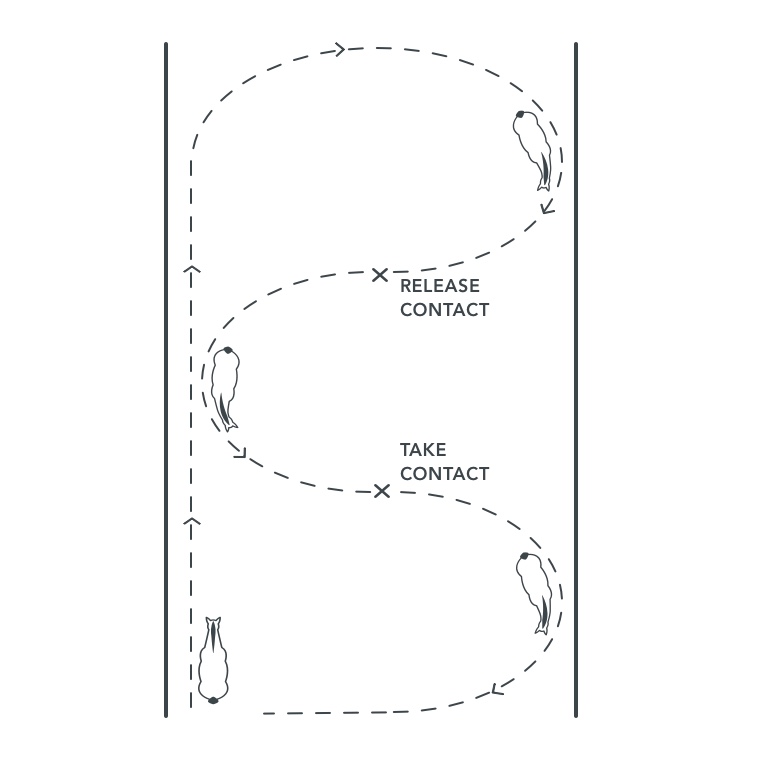
Things to Note:
- Count the beats in your head or out loud if that will help you stay in time.
- When your horse is in a good rhythm they should feel neither slow or too fast. Your horse should be bending their joints properly and covering ground.
- If you think your horse is struggling with finding their rhythm, the likely cause is that you are using your hands too much to collect them too early. It is important to maintain a light contact with your horse when they are finding their rhythm and allow them to search for the contact instead of forcing it upon them. Allowing them to do this will result in a truer contact and a happy horse!
📚 Must read blogpost: 4 Exercises to Improve the Direction of Your Horse
Connection & Impulsion
When we talk about connection we want to aim to have a contact which is light and has an elastic feeling in both reins which comes from your seat and legs, not your hands.
Your horse can only have a proper contact with the bit if they have fluid connection from their hind quarters to your hand. This means that the energy generated in their hindquarters must flow through their whole body before it reaches the reins. Your contact should be steady and adjustable.
Impulsion is the contained power of your horse. As this power comes from your horse’s hindlegs, you want to encourage them to take more energetic steps while they place their legs further under their body and then catch the power in your hands before it runs away. When you feel the power ‘run’ away it will mean that your horse has just gotten faster instead of taking bigger and more powerful steps.
Exercise #2
In this exercise you will learn how to build a connection in a very simple but effective way:
- Ride in a straight line up the long side of the area and do 3 transitions within the pace eg. Trot – Walk – Trot, Canter – Trot – Canter etc…
- Continue through the short side and ride across the diagonal, asking for an extension of the pace through the middle of the arena. (see visual for marks on where we suggest to do this).
- To make the extension as easy as possible I recommend to steady the pace as much as you can through the corner and first few strides of the diagonal to get your horse balanced before you ask for lengthening.
- Allow enough time to bring your horse back to a steady pace before you reach the other side of the arena and go through the corner.
- You can now do the same thing on the other rein or do a circle and go back to the starting point to start over, you can do this exercise as many times as you like, don’t forget to do the exercise for an equal amount of time on each rein.
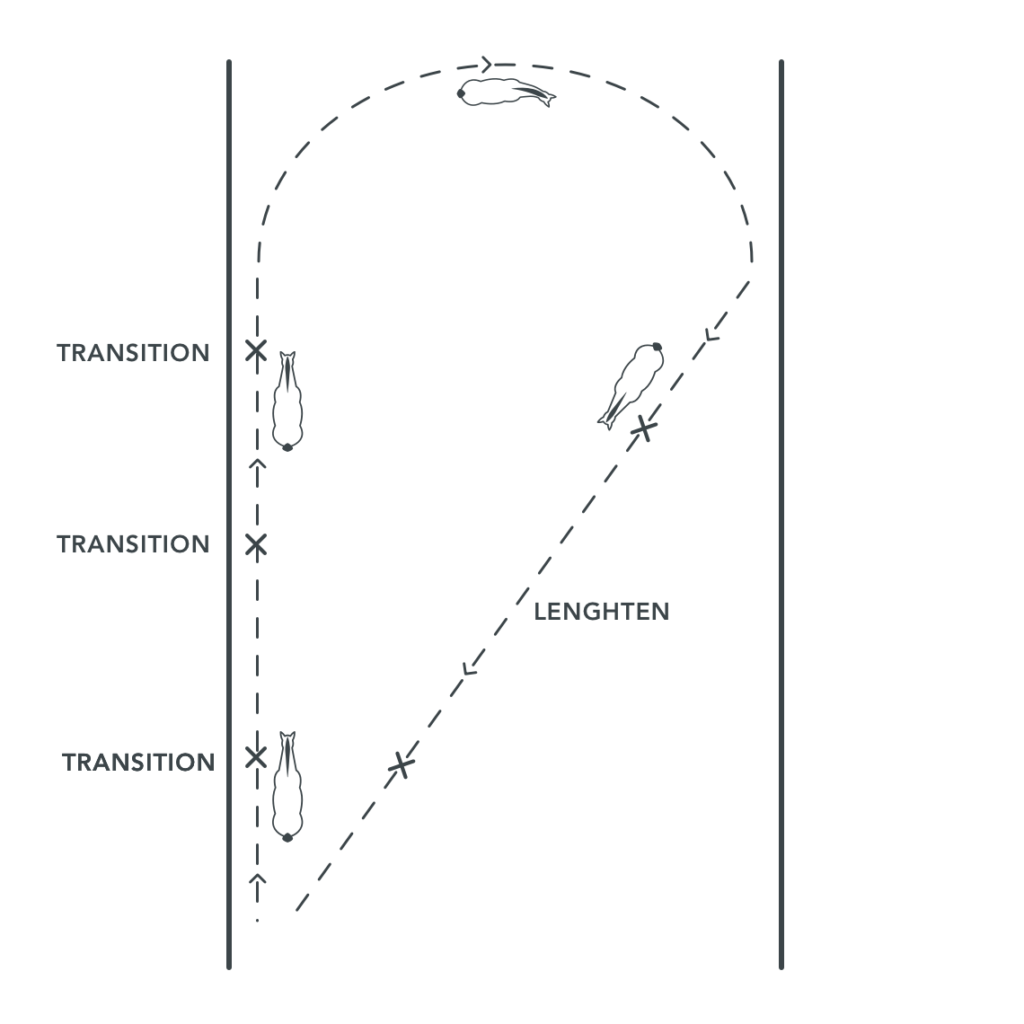
Things to Note:
- You may choose whether to do this exercise in walk, trot or canter.
- It is important for you to prepare for each transition so they can be executed as smoothly as possible.
- You should be completing a total of 6 transitions each lap
If you’d like some more exercises to improve your impulsion check out our blog article here: Improve Your Horse’s Impulsion
Straightness & Collection
In order to complete exercises which focus on straightness & collection it is assumed that your horse has a basic knowledge of rhythm, relaxation, connection & impulsion.
By nature, every horse is crooked, stiff or off balance in some way and it is our job to assist them to build up these muscles and rebalance themselves. The aim is that your horses hind legs step into the tracks of their forelegs, both on a straight line and on a circle, and that you have an even feel in your reins.
The art of collection is when your horse is well balanced and can move their weight in any direction. This then gives them more freedom to move their body and shoulders around, which is proven true when Grand Prix dressage horses can trot on the spot in piaffe or turn around practically on the spot in a canter pirouette.
See here our detailed blog about collection!
Straightness and collection are incredibly important in order to be able to complete higher level dressage movements but it is only possible to achieve full collection if your horse is straight first.
With these points in mind we will now introduce you to an exercise which will help you with your straightness and collection!
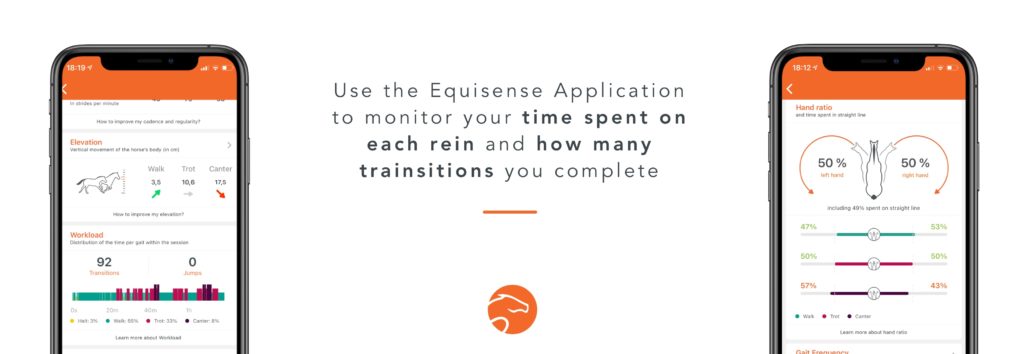
Exercise #3
In this exercise we are going to build on from exercise 2 and make it slightly more challenging …
- Ride shoulder in down the long side, just before you get to the center of the arena, relax your flexion to become straight and perform a 10m circle towards the inside.
- Exit the 10m circle and return to shoulder in, continue down the long side and relax your flexion to become straight and ride a half 20m circle through the short side.
- Perform an extension across the diagonal for whichever gait you have ridden through the exercise.
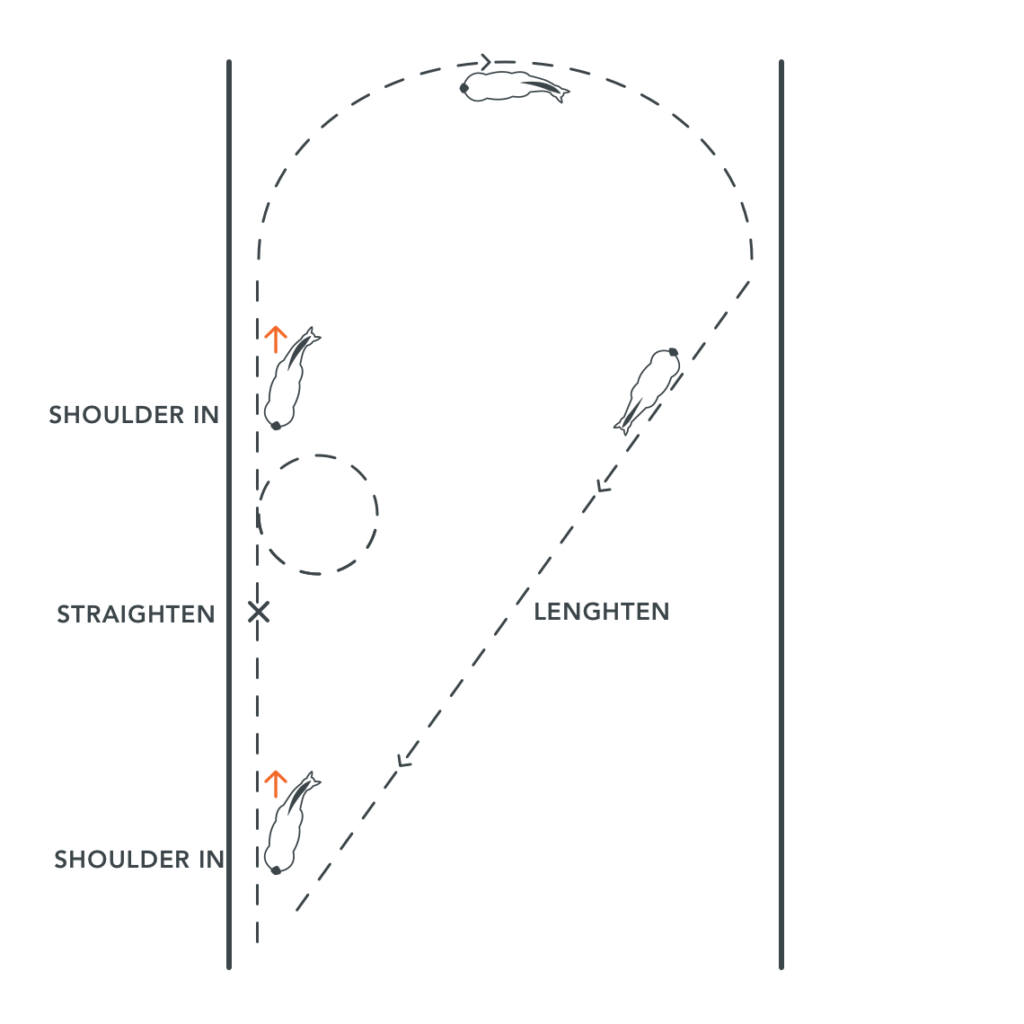
Things to Note:
- This exercise can be ridden in walk, trot or canter.
- While you perform this exercise ensure that your horse is forward, supple and balanced.
- This exercise will help your horse gain strength in straightness & collection specifically but is also a good exercise for overall muscle development.
⚠️IMPORTANT TO NOTE FOR ALL EXERCISES ⚠️
Don’t forget to use the Motion S to calculate your time on each rein to ensure consistency.
As a general rule, the levels in the Dressage Pyramid should be approached in order. There can be times when one is skipped over to work on another. However, until your horse works through rhythm, it will be difficult to create suppleness and until suppleness, creating a steady contact will be difficult and until a true contact is achieved, impulsion will seem far in the distance. Therefore, we recommend staying true to the dressage pyramid levels as much as you can in order to create a fluid training regime.
As you become more and more familiar with the dressage pyramid of training you will start to create a clearer line of communication between you and your horse which will make your training sessions become more enjoyable and positive for you both!
You can also see here a blog about how to create a training plan for your horse!
See you soon,
Nicole from Equisense & EquiCare
Linkes Used:
https://dressageridertraining.com/dressage/what-is-dressage-and-how-do-you-get-started
https://dressagetoday.com/theory/how-to-use-the-dressage-pyramid-of-training
https://howtodressage.com/dressage-theory/dressage-training-plan/
https://www.horseproperties.net/blog/horse-training-basic-dressage-important/
https://www.dressage-academy.com/training/rhythm/